We are familiar with several standalone brands that have leveraged celebrity power from time immemorial, like Thums Up or Mondelez, to endear themselves to consumers. But if one were to expand that to a category, the pan masala brands in India have since forever held the distinction of roping in the biggest celebrities from Bollywood and cricket as their endorsers. From Amitabh Bachchan and Shah Rukh Khan to Akshay Kumar, Ajay Devgn, Ranveer Singh, Virender Sehwag, Kapil Dev, et al., the highest-paid endorsers have associated themselves with the pan masala brands despite the category’s track record of inadvertently stirring up controversy. Advertising clearly has had a love-hate relationship with the pan masala behemoths, and even recently, as per reports, the Health Ministry is believed to have advised the BCCI to remove tobacco-related advertisements from stadiums, in what can be a major blow to the pan masala brands. Incidentally, the category has been one of the top advertisers in cricketing properties, like the recently concluded T20 World Cup and the IPL. Since the ban on advertisements of tobacco products in India in 2004, pan masala brands have been suspected of advertising using surrogates for tobacco products bearing the same name. The products being advertised are, of course, mouth fresheners, teeth whiteners, etc.
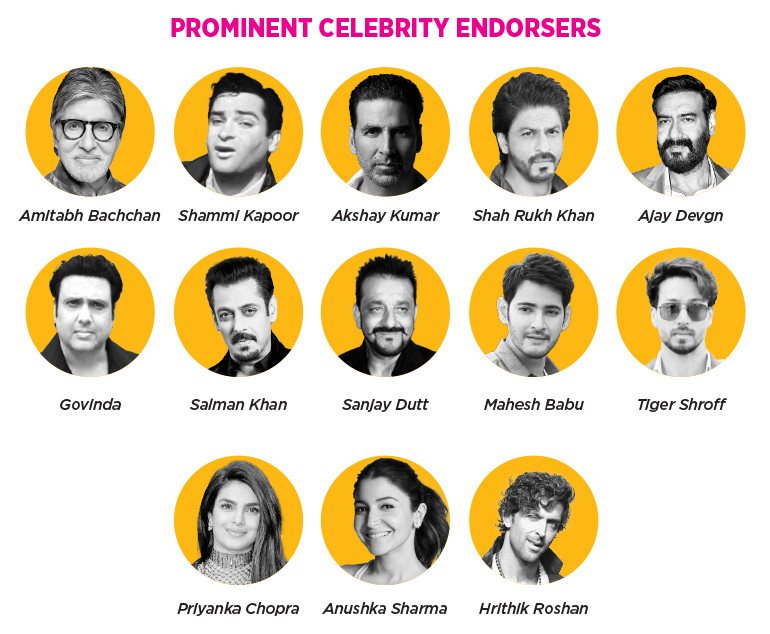
In another development, The Delhi High Court has ruled in favour of the Central Government’s decision to increase the warning label size on Pan Masala products by 50%, pointing at a packaging revamp which may temporarily hit the brakes on the sale of these brands, details on implementation of this regulation are awaited.
Industry professionals note that while the government might be getting sterner about these surrogate ads and their promotions, the process of manufacturing and selling remains rather unaffected. Highlighting the scale of the industry, Vinay Hegde, CEO Media Investments, Madison Media brings to our attention that, with a GST of 28% levied on them, these products are a high source of revenue for the government.
Talking about how these brands are reacting to the strictures, he adds, “Pan Masala companies have started diversifying into other categories including FMCG and Real Estate and may still be able to keep the brand name alive even if the GOI curbs pan masala products from even surrogate advertising. An example for this is Manikchand’s Oxyrich mineral water. From clever surrogate advertising, they may now resort to more direct communication, with the overarching strategy being to keep the brand name and image alive and strong in the consumer’s minds.”
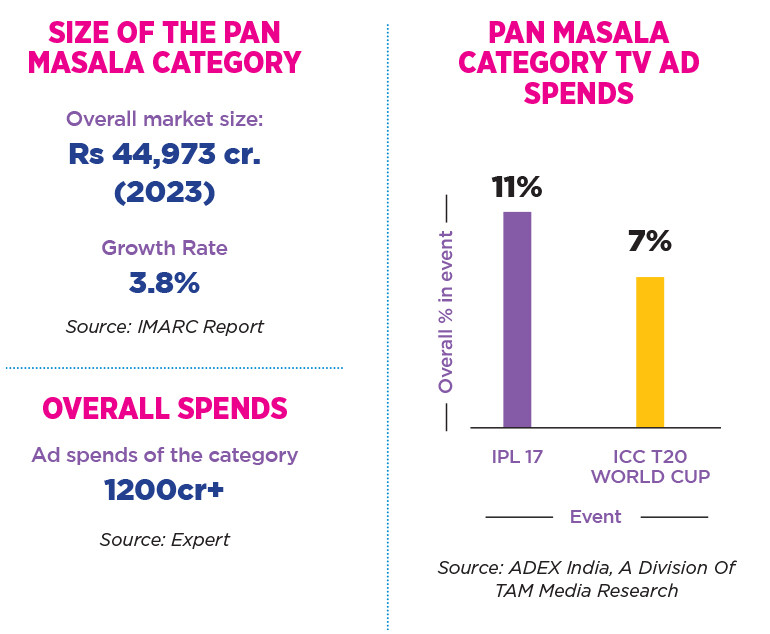
The ad game
The overall market size of the ‘Pan Masala’ category is Rs 44,973 cr. (2023), and is estimated to reach Rs 62,067.7 cr. by 2032, at a growth rate of 3.8%, according to an IMARC report. The category’s overall contribution to Indian AdEx is an estimated Rs 1200 cr, according to a media expert, who also mentioned that their preference of media remains influenced by the masses.
The T20 World Cup is one of the most recent examples of the mass-media approach, where Pan Masala was the number 2 advertiser category according to TAM, with Vimal Elaichi Pan Masala being the top brand to be advertising (as per volume). Vishnu Packaging and KP Pan Foods; and Vimal Elaichi Pan Masala and Kamla Pasand Silver Coated Elaichi were also amongst the ‘Top 5 advertisers’ and ‘Top 5 brands’, respectively, with regards to ad volumes in IPL 2024, as per TAM.
Vishnu Packaging (makers of Vimal Pan Masala) has gained 19 positions to reach the 17th rank in the Top Advertisers in India 2023 list, as per the Pitch Madison Advertising Report 2024. The brand’s ad spends range is about Rs 450-550 cr, which is nearly double of what it was in the year before.
According to TAM data for the period of January-July 2024, Vishnu Packaging continues to be the top advertiser in the category with a 35% share in terms of ad volumes on TV, followed by the Dharampal Satyapal Group (makers of Rajnigandha) with a 19% share and K P Paan Foods (makers of Kamla Pasand) with a 16% share.
Another interesting aspect on the way they operate is that the total ad spends of the category is highly concentrated in one big campaign during a season. While the number of campaigns dispensed in a year may be minimal, the impact it has on AdEx is notable.
IMPACT reached out to several agencies, including top-of- the-line and middle order ones, most of them said they had not worked with pan masala brands or refused to share a comment due to the nature of the category. Some of the agencies also have a stance on not promoting a pan masala brand, even if they may have alcohol brands in their portfolio. Active pitching is only a norm for the more organised companies such as DS Group that follow a functional structure. Despite being a sizable contributing category to AdEx, most agencies are not overtly showing interest in partnering with the brands in it.
An exception is Azazul Haque, Group Chief Creative Officer, Creativeland Asia who states, “I’ve always been vocal about the fact that I don’t have a problem in working with a category that is legally permitted but may need a surrogate. If we talk about health hazards, we know a lot of packaged foods being advertised are not good for health, even beverages with excess sugar have health concerns”. He further adds that some agencies may also shy away from the category because of the strata it caters to, and the agencies do not see any creative glory in it.
Shradha Agarwal, Co- Founder & CEO, Grapes adds that it also has to do with how the audience perceives it. She explains, “Alcohol and cigarettes are cool, but Pan Masala is not cool. Pan Masala is not good for your teeth, but alcohol and cigarettes are also destroying the body. It’s just a trend that declares the category as ‘uncool’, that is where I think a challenge for these brands comes in because they’re also driving imagery and not just sales.”
Manish Bhatt, Founder & Director, Scarecrow M&C Saatchi, who has been a long-term collaborator with DS Group and has worked on a campaign for Rajnigandha, has a philosophy of remaining neutral with the business, providing intellectual solutions and expertise to the ever-evolving landscape and giving people a fair chance to choose from the shelf. “It’s the consumer who knows and understands what is good and what is not. We are not forcing anyone to consume a product, we’re just helping to put things on the shelf. It shouldn’t be judged. There are rules and laws to regulate the product, that law flattens everything out”, he adds.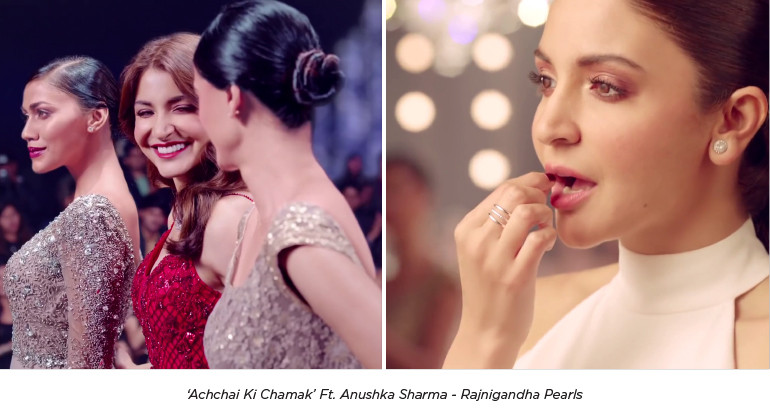
Keigan Pinto, ex Chief Creative Officer, FCB Ulka shares that the reason he has not worked on any campaign in this category is because the opportunity has not come by, and it could also be a conflict of interest because of another brand he handled in the ingestible edible spectrum.
Sharing his thoughts on the contradictory stance of agencies, he reckons that it’s not for you and me to decide what should be and should not be promoted. “A commercially available cigarette seems legitimate to the human mind but it is not. It’s all unethical. So why should we make these guys soft targets?” he adds.
Pinto believes that it’s driven by the masculinist approach, which is affected a bit by the personalities of these brands, which are not docile. They do not need month-on-month communication because it is primarily driven by a single stimulus which is the habit of consumption, and that’s why they seem to have a legacy of doing a big-bang campaign, going all out on media spends, and then getting out.
Azazul Haque, who has been working with brands such as Rajshree and Kamla Pasand as a consultant, mentions that the majority in the category is more dependent on consultants rather than the client-agency relationship and retainer models. Several of these traditional businesses have been passed on from one generation to the other. He shares, “The reason for that is they want a slightly higher ROI, they don’t need a campaign every two months. They gamble once a year. So having a monthly fee model doesn’t make sense for them”.
Also, at a time when Digital AdEx has zoomed past the other mediums in growth and most brands have jumped on the bandwagon, Pan Masala brands are resolutely going against the tide by heavily investing on the traditional media.
Deepika Bansal, AVP - Investment, dentsu X shares, “Pan masala consumption is deeply ingrained in cultural and regional traditions. Radio advertising being a hyperlocal medium can have more local and cultural preferences in creative and impact”.
Bhatt, on the other hand shares that reach and efficacy are important factors for the Pan Masala category, and considering that Digital is highly targeted, it does not reach every nook and corner of the country.

Agarwal states that when it comes to digital penetration of the category’s target audience, there are only two mediums - WhatsApp and YouTube; you can’t advertise on WhatsApp, and there is only so much advertising that can be done on YouTube; a whole media plan cannot be created there. She adds, “It’s more about the mass, you don’t want to reach the elite. You only reach the mass.”
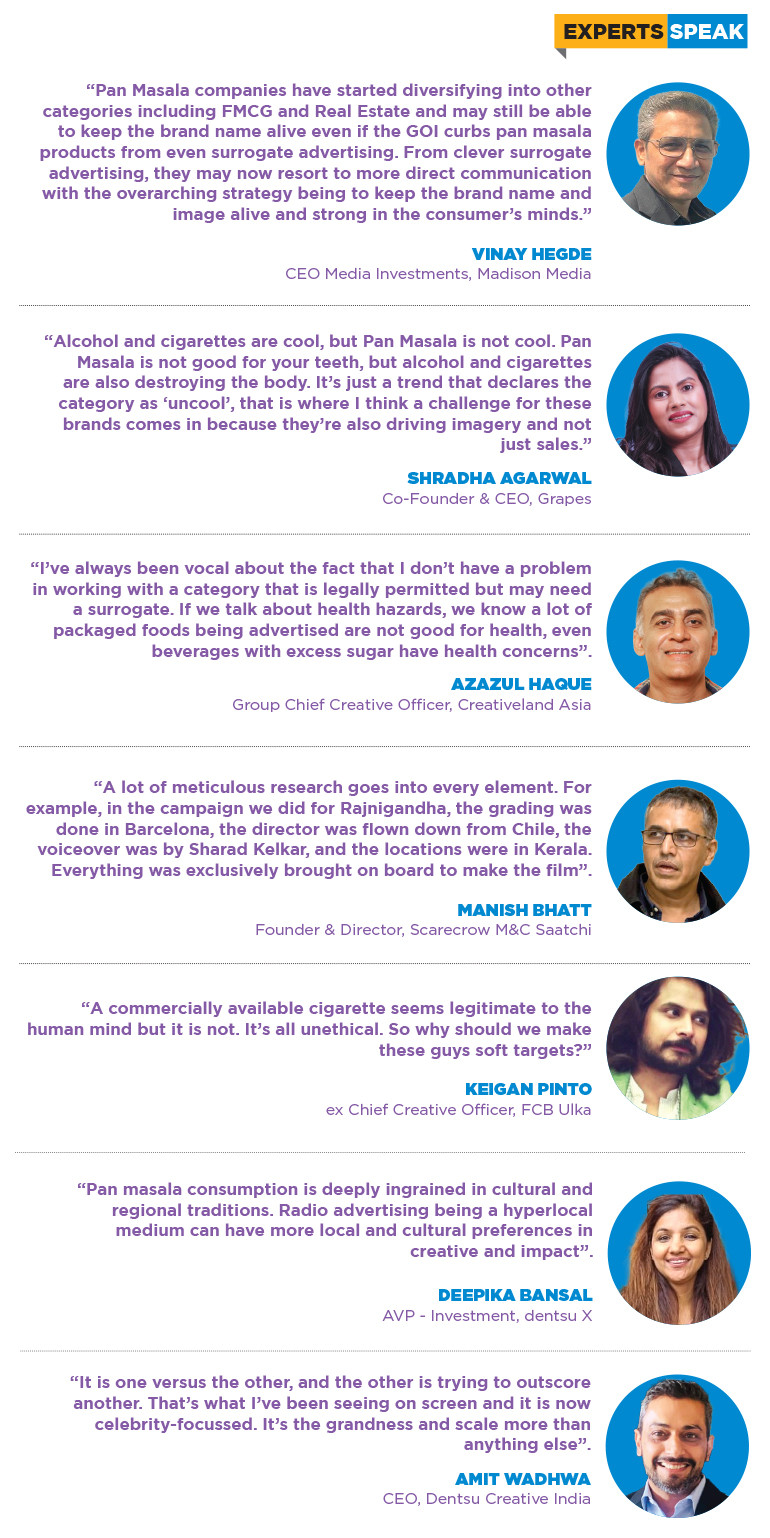
The narrative of success
Agarwal of Grapes also highlights that the opportunities to advertise have limitations for this category. She further states, “They choose opportunities that have the maximum brand reach. That’s why brands such as Rajnigandha, Vimal, or Shikhar would go for cricket or movies.”
The campaigns in this category have sustained a template for years. This template has been the narrative of success. The protagonist in these campaigns has always been opulently successful or becomes so in the climax. The stories are framed in exotic locations, with plush cars, and grand mansions. The product is always the choice for these successful characters or rather the product here is the key ingredient to success.
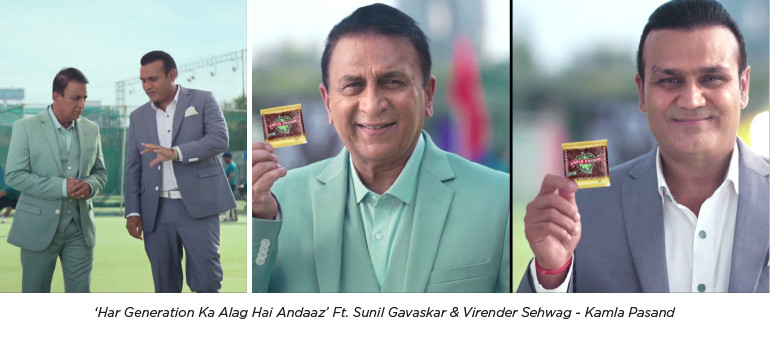
While the A&M industry has several rapidly changing template trends, such as brand anthems during cricketing seasons, emotional homecoming dramas during festive seasons, and more, the ‘success’ narrative in the Pan Masala category has predominantly sustained through the majority of the brands in the category for years.
There are very few brands in the category that differentiate themselves from others such as Rajnigandha, and Kamla Pasand. Rajnigandha has come a long way since its narrative of success, the famous, ‘Mu Main Rajnigandha, Kadmo Main Duniya’. Bhatt who worked on one of the recent campaigns for Rajnigandha showcasing product ingredients, states, “If you see the film, you’ll understand how different it is from others. We are not copying anybody’s style, we did it our way.”
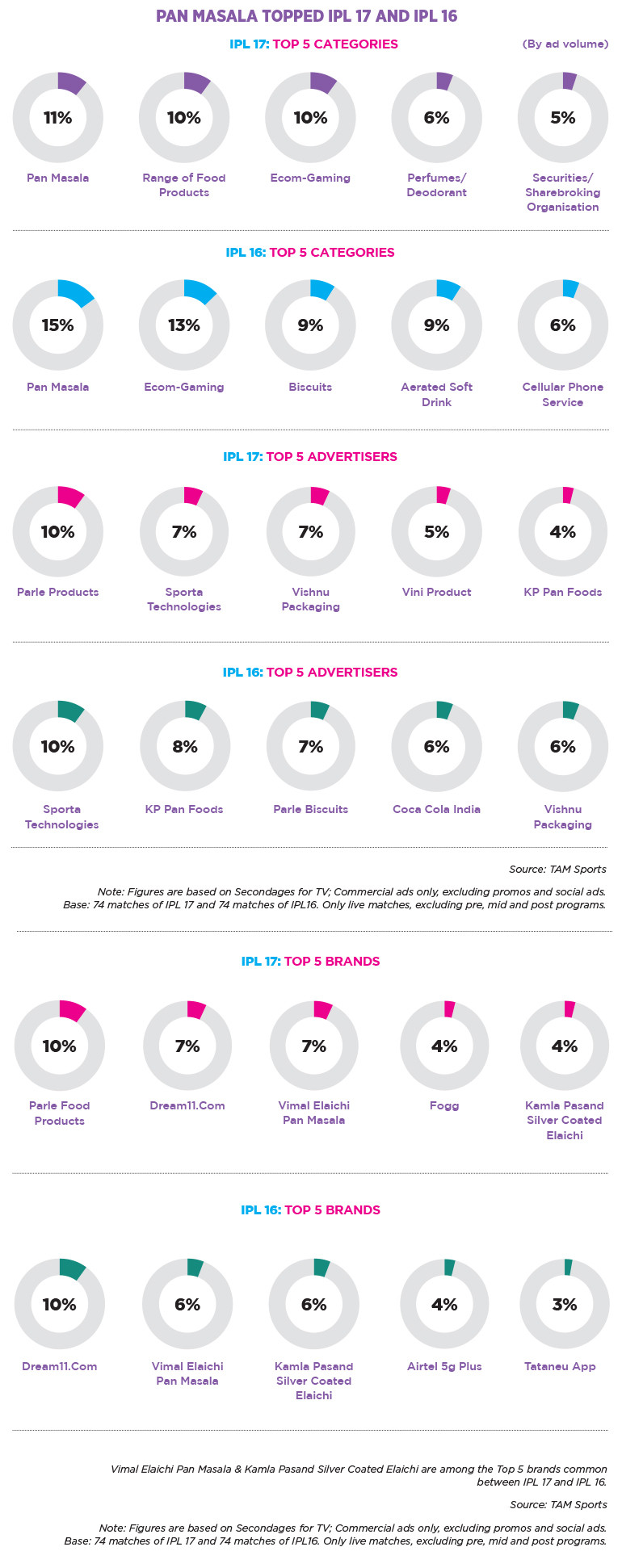
High production budget
Amit Wadhwa, CEO, Dentsu Creative India, who has worked on a campaign for Rajnigandha during his stint at Dentsu Impact, mentions that the competitive category is now moving to scale. He adds, “It is one versus the other, and the other is trying to outscore another. That’s what I’ve been seeing on screen and it is now celebrity-focussed. It’s the grandness and scale more than anything else”.
This is also a category that goes all out when it comes to production value of the ads in addition to the massive media spends. Whether it’s the locations, actors, or costumes, every detail goes through elaborate research. Bhatt of Scarecrow M&C Saatchi shares, “A lot of meticulous research goes into every element. For example, in the campaign we did for Rajnigandha, the grading was done in Barcelona, the director was flown down from Chile, the voiceover was by Sharad Kelkar, and the locations were in Kerala. Everything was exclusively brought on board to make the film”.

 Kapil Tammal, National Creative Director, Scarecrow M&C Saatchi mentions it’s a highly competitive market and the production budgets are also high. “In most ads, we see a fair amount of CGI, foreign faces, and exotic locations. The budgets are usually 50% higher than the industry standards”.
Kapil Tammal, National Creative Director, Scarecrow M&C Saatchi mentions it’s a highly competitive market and the production budgets are also high. “In most ads, we see a fair amount of CGI, foreign faces, and exotic locations. The budgets are usually 50% higher than the industry standards”.
Talking about numbers, a spokesperson from the production industry revealed that the ad production cost for a day with a celebrity involved can go as high as Rs 2 cr. The celebrities on board usually have a yearly endorsement contract which includes a campaign with few ad films, and still shoots for Print and digital amplification. The likes of Shah Rukh Khan, Ajay Devgn, and more in the league charge anywhere between Rs 5-8 cr. for an endorsement deal, depending on their market value in real-time. Priyanka Chopra charged an estimate of Rs 50 lakhs for a day’s shoot for an ad she did in 2017 in this category.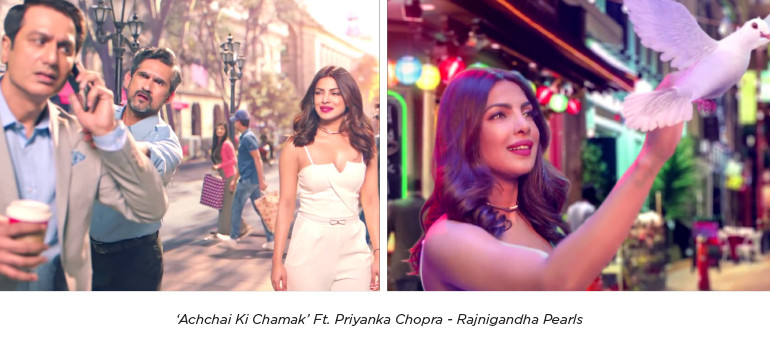
 Ramakrishnan R, Co-Founder & Director, Baseline Ventures, mentions that there could also be a premium when it comes to pan masala ads, as these are categories with a high churn of cash, so the ask is more, in terms of money. He further highlights another factor that adds up to the cost. “There’s an element of risk here, so to mitigate that, there may be a premium of 20-30% added,” he says.
Ramakrishnan R, Co-Founder & Director, Baseline Ventures, mentions that there could also be a premium when it comes to pan masala ads, as these are categories with a high churn of cash, so the ask is more, in terms of money. He further highlights another factor that adds up to the cost. “There’s an element of risk here, so to mitigate that, there may be a premium of 20-30% added,” he says. Mansi Shah, Brand Planning Director, Famous Innovations reckons building aspirations is the most popular way of building desire or for any product or the brand. She adds, “With an ever-increasing negative sentiment around the product, it becomes all the more important for brands to project the grandness”. She also highlights the need for borrowing from the alcohol category, where these brands take up a lot of initiatives to talk about issues. She says, “Even the pan masala category needs to step up and spend a little bit from their deep pockets around tackling issues like spitting in public and maintaining cleanliness.”
Mansi Shah, Brand Planning Director, Famous Innovations reckons building aspirations is the most popular way of building desire or for any product or the brand. She adds, “With an ever-increasing negative sentiment around the product, it becomes all the more important for brands to project the grandness”. She also highlights the need for borrowing from the alcohol category, where these brands take up a lot of initiatives to talk about issues. She says, “Even the pan masala category needs to step up and spend a little bit from their deep pockets around tackling issues like spitting in public and maintaining cleanliness.”
With minimum campaigns that create maximum impact, the Pan Masala category continues to thrive and create a share of voice by going against the industry trends and going all out on media spends.
Pan Masala and controversies
When the goal is reaching the masses, celebrities in India are the single-most effective vehicle in the country, and celebrities that reach the masses in India either hail from cinema or cricket. The pan masala category has had a history of roping in some of the biggest names from both verticals. Whether it’s Shammi Kapoor or Shah Rukh Khan, from the times when TVCs dominated to the digital age, some of the most popular names have been attached to the category.
One of the brands, Pan Bahar, went a step further when they roped in global film personality Pierce Brosnan as an endorser for their campaign. While the TVC garnered the intended eyeballs and attention, it also led to a controversy surrounding the brand. Brosnan later released a statement in a written reply to the Delhi State Tobacco Control Cell saying he got cheated by the brand that called the product a ‘breath freshener/tooth whitener,’ according to media reports. He added that he was unaware that the product contained tobacco or ingredients that may be cancerous.
Brosnan is not the only celebrity to have later regretted the endorsement with a pan masala brand, there’s a long list. In 2022, Akshay Kumar was under fire for his association with Vimal Elaichi, as his endorsement did not match his overall stance of promoting health and fitness and appearing in government-sanctioned ads against cigarette smoking.
He announced his withdrawal from the endorsement after the outpouring backlash and mentioned that the ads may run until the time the contract is legally binding on him, but he would no longer be associated with the brand. When the next set of ad films was aired during IPL 16, he was under fire again.
When an entertainment publisher called out the actor for his ‘return as a Vimal endorser’ he informed them saying the ads were shot in October, 2021, and he has not been associated with the brand since the public announcement of his discontinuation of the endorsement.
Amitabh Bachchan was another celebrity who withdrew his endorsement for Kamla Pasand after he faced flak for allegedly avoiding his social responsibility and promoting Kamla Pasand in a campaign featuring him and Ranveer Singh. Reportedly, he terminated the contract and also returned his endorsement fees.
Pan Masala has always been a part of popular culture on the internet, but as ad volumes during big-ticket events such as IPL and CWC have increased, so have the conversations around the campaigns from the category. Not just placed during breaks in the cricketing tournament, the campaigns have featured iconic cricketers too. Kamla Pasand roped in Sunil Gavaskar, Kapil Dev, Virender Sehwag, & Chris Gayle for an ad campaign.
Gautam Gambhir stirred a controversy with his statement on the ad saying it is “disgusting and disappointing”. He further stated that these personalities are considered to be role models and are setting the wrong precedence for future generations of cricketers. On the regulatory end, the law firmly prohibits surrogate advertisements for tobacco.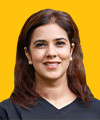 ASCI’s guidelines differentiate between authorised brand extensions and banned surrogates. Manisha Kapoor, CEO & SG, ASCI, states, “Celebrity endorsements are restricted for products with health warnings while endorsing brand extensions remains permissible. Celebrities, with their significant influence, are accountable for aligning with government regulations. ASCI is committed to upholding ethical advertising, ensuring a clear distinction between valid brand extensions and prohibited surrogates. The emphasis is on the importance of due diligence in celebrity endorsements for both ethical and legal compliance”.
ASCI’s guidelines differentiate between authorised brand extensions and banned surrogates. Manisha Kapoor, CEO & SG, ASCI, states, “Celebrity endorsements are restricted for products with health warnings while endorsing brand extensions remains permissible. Celebrities, with their significant influence, are accountable for aligning with government regulations. ASCI is committed to upholding ethical advertising, ensuring a clear distinction between valid brand extensions and prohibited surrogates. The emphasis is on the importance of due diligence in celebrity endorsements for both ethical and legal compliance”.
(with inputs from Aryan Khanna)























